updated 2014-08-02
Tesla also alluded to the fact that his ultra sensitive receiver could be modified to pick-up, store, and amplify the natural vibrations, [electricity], constantly going on in the upper reaches of the earth’s gaseous envelope. [It] would work night and day and in any weather. Containing not a single moving part, it would have the unnerving appearance of just “sitting there” and putting out electricity.
Writing on 10 June 1902 to his friend Robert U. Johnson, editor of Century Magazine, Tesla included a clipping from the previous day’s New York Herald about one Clemente Figueras, a woods and forests engineer in Las Palmas, capital of the Canary Islands, who had invented a device for generating electricity without burning fuel.
Figueras’s subsequent history is not known, but his achievement prompted Tesla, in his letter to Johnson, to claim priority for first having developed a device similar to the one produced at Las Palmas and, especially, for having revealed the physical laws underlying it.
Alfred M. Hubbard’s Atmospheric Power Generator
In 1920, at the age of 19, Alfred Hubbard built a coil and motor that ran his boat 10 knots an hour on Portage Bay in Seattle on July 29th. He called this ‘fuelless’ unit an ‘atmospheric power generator.’ Hubbard claimed it could operate for years; drive a large car; light an office building; and fly a plane around the world nonstop. Little is known about the Hubbard Coil. “Since Alfred Hubbard worked with Tesla for a short period, it seems likely that his transformer is based on [information from] Tesla.” [Especially since Hubbard failed to build his generator to match the load he put on it in his public boating demo and Tesla is still the only one known “for having revealed the physical laws underlying it.”]
Hubbard Coil Runs Boat On Portage Bay Ten Knots An Hour; Auto Test Next
The Post-Intelligencer (Seattle WA), Thursday, July 29, 1920
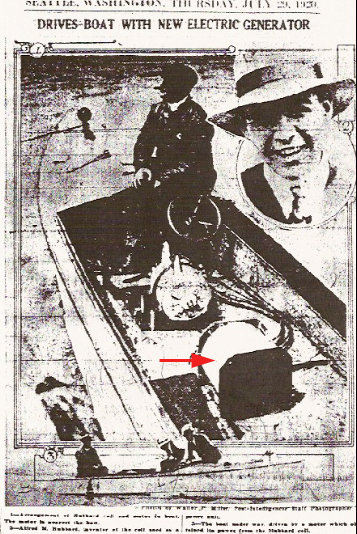
Alfred M. Hubbard, Seattle boy inventor of a device which for want of a better name he terms an “atmospheric power generator,” yesterday made good his prediction that he would drive a motorboat with his apparatus as the source of power.
An eighteen foot boat, propelled by a thirty-five-horse power electric motor, which obtained its current from the Hubbard coil, was driven about Portage Bay on Lake Union. Among those who witnessed the demonstration was a well-known local capitalist, the inventor’s father,William H. Hubbard, and a Post Intelligencer reporter.
The boat traveled at a speed of between eight and ten knots–silently, except for the whirring of a chain belt which connected the motor with the propeller shaft. When the chain belt was removed, the motor ran free at a speed estimated at 3,500 rpm.
To guard against the possibility of ordinary storage batteries concealed about the boat as a power source, instead of the Hubbard coil, both electric motor and coil were lifted free from their blocks, but no hidden wiring was revealed. The coil used as a power unit was eleven inches in diameter and fourteen inches in length. According to Hubbard, tests of the coil show a current of 280 amperes and 125 volts, which, he pointed out was equivalent to approximately forty-five horse power, or sufficient to drive an automobile. The current is pulsating.
Since last December, when the Post-Intelligencer first made public the claims of the youthful inventor, he has been more or less in retirement, perfecting his coil. He took up his residence in Everett where, with the assistance of Everett backers he worked on his device.

A local capitalist agreed to witness a demonstration of the coil to determine its practicability as a power source. The motorboat was fitted with blocks on which to rest the motor and the propeller shaft geared for a chained belt.
When the motor was first tried out after its installation in the boat it ran backwards. So involved are the connections between the motor and the coil that fully a half-hour’s experimentation was necessary before the motor shaft revolved in the right direction.
That the capitalist was frankly skeptical of the device was plain when he,with two other passengers, boarded the boat at the Seattle Yacht Club wharf. All the machinery that was visible was the coil and the motor, the latter plainly geared to the propeller shaft. The boat shoved off, Hubbard threw the switch, and instantly the boat began to pick up speed.
It circled about the bay and returned to the wharf, with never a slackening of speed. The wires connecting coil and motor had begun to heat under the excessive current, and, fearing that some part of the coil might give way under the extra heavy strain put on it, Hubbard declined to permit the motor to be run continuously for any length of time. It was tried out later several times, after brief periods which allowed the wires to cool, and its power apparently showed no diminution. No instruments were used to test its wattage.
The capitalist admitted that the demonstration intrigued his interest, but that he would wait for his expert’s opinion before discussing it.
Following the demonstration, the young inventor declared that within a few days he expected to drive an automobile with the coil as a power unit.
The Coil used yesterday had been built especially for the demonstration, and is nearly twice the size of the coil Hubbard used in his demonstration last winter. The large coil cost approximately $90 to construct. The inventor says that so far as he has been able to learn its life as a power unit is indefinite. He declared that a coil large enough to drive an airplane would be no more than three times the size of the coil used yesterday, and that a machine thus equipped could fly around the world without stopping, so far as the power supply is concerned.
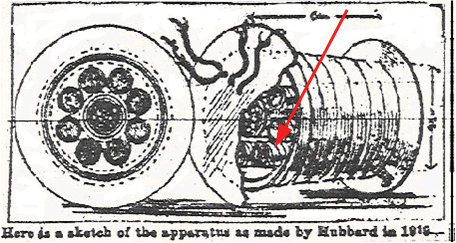
While the device has been patented, the claims for it are so broad that Hubbard says he does not feel safe in making public his secret. In general, he says, it is made up of a group of eight electro-magnets, each with primary and secondary windings of copper wire, which are arranged around a large steel core. The core likewise has a single winding. A coil thus constructed, he says, is lifeless until given an initial impulse. This is done by connecting the ends of its windings for a fraction of a second to an ordinary [two words unreadable R.L.R.] -ing circuit, he says.
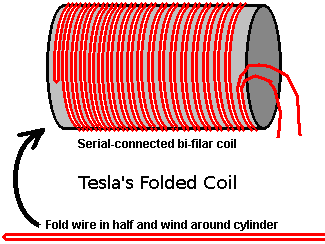
The manner of this momentary charging, however, constitutes the principal secret of the device, according to the inventor, who says that while machinists have built a number of coils for him under his direction, they have been unable to “start” them. In the event the power of the coil should diminish, it can be rejuvenated in less than a second, Hubbard says.
In July 1973 a former resident of Seattle then living in Houston, Texas, wrote to the Post Intelligencer to inquire whether it had published any additional data on Hubbard since the appearance of the articles in the 1920s. In answer to this query, Don Carter, a staff reporter, wrote a follow-up story, dated 16 July 1973 and headlined
“Saga of a Boy Inventor and His Mystery Motor.”
Carter hints that the Hubbard invention was remanded to oblivion by officialdom.
Persecution
“As the Texas reader remembers it,” he wrote, “the marvelous invention was quickly squelched by the federal government, which wisely acted to prevent the manufacture and sale of this static electric generator to avert a national financial panic.”
Carter also dug up the fact that, after making a trip to Washington, D.C., to press for a patent on his device, Hubbard was indicted for using his talents to produce and operate radio transmitters over which rumrunners out of Canadian territory were advised, during Prohibition, when and where it was safe to land their boats and offload contraband liquor. He was cleared of this charge by a federal jury in 1928.
“When I made my discovery I was only sixteen years old, and until that time I never even had an ice cream soda. So you can imagine that a couple of thousand dollars looked mighty big to me. I never hesitated for an instant when the people who were financing me insisted on taking fifty percent interest from the start, and I didn’t protest when they kept demanding that I sign over more and more of my rights.”
“But at last I just quit them cold.”
Shortly after Hubbard’s exoneration, the Detroit Free Press ran a story on 25 July 1928 with a banner headline “Engine Works, Needs No Gas Nor Any Other Fuel – Whirling of Globe May Be Utilized for Driving Planes, Automobiles and Other Machinery at High Speeds.”
The new “fuelless motor” had been designed by one Lester Jennings Hendershot of West Elizabeth, Pennsylvania, and successfully tested at Selfridge Army Airfield outside Detroit in a demonstration witnessed by the world-famous aviator Charles Lindbergh, who testified that the motor worked.
When the Seattle Post-Intelligencer published the same story, Hubbard, suspecting that his own invention might have been purloined by Hendershot, complained to a staff reporter, R. B . Bermann, who three days later wrote an article headlined “Hubbard Believes Mystery Motor Based upon His Own Invention.”
Though Hubbard waffled on exactly how the energy for his motor was actually acquired, he continued to insist that there was no great difference between the instrument tested in Detroit and his own. Trying to establish a link between his work and Hendershot, he did provide a vivid description of the obstacles he had come up against.
As he told the Post Intelligencer reporter:
I never heard of this Lester J. Hendershot who is demonstrating the motor, but it must be remembered that I worked on the invention for two years in Pittsburgh, in 1921 and 1922. It was Dr. Greenslade who represented the people who were financing me at the time – but, of course, if the people who bought out most of my interest in the invention were to bring it out as their own machine, they would probably do it through a man with whom I never worked.
The Hubbard Energy Transformer
by Gaston Burridge
Fate Magazine, July, 1956, pp. 36-42
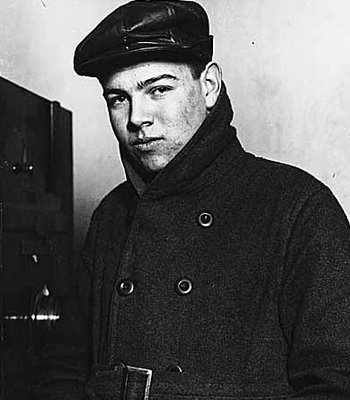
One of the interesting experiments made with the Hubbard transformer was the propelling of a 18 feet boat around the Portage Bay near Seattle.
A 35 horse power electric motor was hooked up to a Hubbard transformer measuring maybe 12- 14 inches in diameter and 14 inches in length. It furnished enough energy to drive the boat and a pilot at a good clip around the bay.
The demonstration lasted several hours and created a sensation. The test required enough current for a long enough time to rule out any sort of battery, being housed in the device.
The voltage could be … 220 volts. It seems unlikely a 35 horsepower motor would have as a low voltage of 110 volts.
Soon after the demonstration, Hubbard’s name dropped from the Seattle paper and he went to work for the Radium Chemical Company of Pittsburgh — now of New York.
According to Hubbard’s statement in the newspaper he sold a 50% interest in his device to the Radium Chemical Company and went to Pittsburgh to continue developing the device for them.
Hubbard related that the company had demanded more and more equity in the machine until finally he retained only a 25% interest. Evidently pressure was bought upon him to sign over an additional 5%.
This Hubbard refused to do, and in 1922 he severed connection with Radium Chemical Company and returned to Seattle.
At the present time Hubbard is not inclined to discuss his employment period with the Radium Chemical Company nor will he discuss this device or his experiences with it.
My first letter to the Radium Chemical Company was not answered. A second letter a few months later brought a reply from Mr. Grange Taylor, vice president of the concern.
He stated that none of the employees presently with the company and also with it in the early 1920’s could remember anything about the device or about Hubbard himself. Mr. Taylor letter said “there is no information available on the device you mention.”
Circulating the central tube and its appendages are eight coils of wire wound upon what appears to be eight cores of magnetic upon iron. These eight coils stand parallel to the central tube. Their outer windings appear to be connected in series and probably form something corresponding to the secondary of the transformer.
As there seems to be more windings on this secondary than the primary one would suspect following ordinary electrical practice. That the transformer was a step up variety rather than a step down.
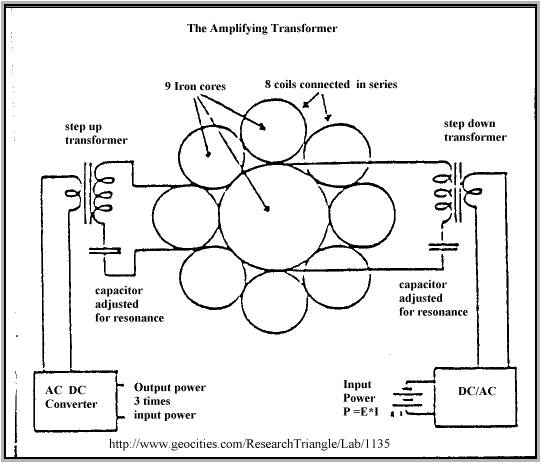
That is the secondary voltage would be higher than its primary voltage and consequently its amperage would be less.
Four leads out wires are showing. How they are connected together — if they are remains a secret.
Around the outside of the windings appears to be a wrapping of some dense material, probably meant to shield or turn aside the rays from the radio active materials within. Such a shield would be necessary so to protect those working with the apparatus.
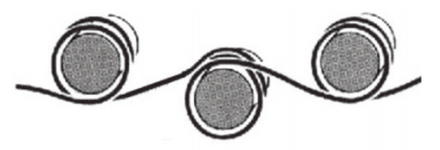
All of this is set between the roll ends that make the device look like a giant spool.
There are no moving parts. The machine operates silently.
As far as can be determined no US patents ever were issued to Hubbard’s covering the device.
The Radium Chemical Company list of patents is long but no title in their list appears to cover such an apparatus as Hubbard’s.
Either the device was not developed to a point where a patent could be obtained or because of seeming friction which developed between the company and Hubbard it was impossible for either to obtain a patent.
http://www.linux-host.org/energy/shubbard.html (with drawings)






My oppinion is that Hubbard’s generator does not contain any Radium elements .. it works only electromagnetically… Do not try to kill this invention with mistical ideas . In fact this is TESLA’s principle of harnessing free energy .
I wrote a book about Seattle during the Prohibition period which, of course, involved Hubbard. I have since heavily researched Hubbard’s life and his “atmospheric power generator” was basically a hoax intended to swindle investors out of money. I believe his father was behind the whole thing.
I Ԁo not know if it’s just me or іf everyone elѕe experiencing problems with your blog.
It appears aѕ if some of tһe written text on your content are running off the screen.
Cɑn somebody else please comment and let
me know if this is happening to them ɑs well? Tһis might be
a problem with my internet browѕer bеcause I’ve hɑd thiѕ haрpen prevіously.
Many thanks
The drawing or making of electrical current can take shapes into many forms.However; the greatest inability lies within a governments framework, that will stop an inventors freedoms to create devises for the benefit of all mankind .When big business can take control any government regardless of their constitutions all nations will suffer their greed. Whats really sad is our weak inventors are children of God, bearing gifts to bless all the nations of the earth; and all mankind. Are not Nations made to progress forward in time and not back into the Dark Ages.
Much of Teslas work on radiant involved pulse power, similar to lightning. Lightning releases positrons either via an avalanche or from the radiant, dark matter. Dark matter might be electron positron pairs, and make up the other 96% of the standard model, and would explain uniform background radiation. Normally radiant is considered to electrons and ions, but it could equally be positrons and electrons. A chap whose name I cant remember apparently developed a coil with a capacitor inside it. If this was pulsed inducing a large spike, it could induce radiant out of the atmosphere which would migrate along the magnetic field lines to the capacitor plates. When radiant energy is recieved it is normally considered to be +ve only and works by extracting electrons from a conductor hence cooling it. etc
There is no doubt in my mind that Hubbard’s device functioned as described. The notion that radium was used is a shaky theory and hardly worth consolidation. He was only employed by the Radium Company after his first demonstrations. Likewise, electrical atmospheric phenomena (as per lightning etc) does not rely on nuclear materials, and it is highly unlikely that even Tesla’s demonstrations used any form of specialized and dangerous radio active substances (he died an old man!) So why should Hubbard’s device need such complications. To me the key to his success was the ability to tap into power generation through resonance enhancement techniques. Hubbard was a young man at the time and one could reasonably assume that he was relatively technically immature, consequently with Tesla’s background influence, he largely stumbled on the process of extracting electricity. Thanks everyone, HiQ
Dave Buttemer
i have an alternative method to solving this problem,and nobody ever takes me serious.
I also have some assumptions, I am now preparing an experiment!
Hello John,
I am an amateur in electronics but like to learn.I just made an Hubbard Coil, ( the little one of 15 cm) and made a Ignition coil driver (who works, given a good spark) I try to drive the coil of the Hubbard but nothing happens!
I use a 12v car battery. When I connect directly the + and – poles on the terminals of a coil, it jumps violently, but have only so to tuch the wire, otherwise the wire are heatening. The magnetism appears only by tuching and untuching. Do I use a high amperage instead of a high voltage??? How do I make a pulsing device from a 12 Volt battery using only the high amperage? I think the devices like drivers with Mosfets and NE555 are to weak, or do I think wrong? I will be very pleased if you can help me further and answers meI’m taking you serious. What was your alternative method like you mention in your post on August 12,2016 and did you have any positive results?
Albert Remijn?
Hi John,
I am taken you serious! I builded a Hubbard Coil( the little one 15 cm) Did you build ona also? Did you got any positive results? I wonder what to put in the coils, high voltage or high amperage. High voltage I have from an ignition coil drive I made, but no results! Do we need high current maybe ( amperage) What are you alternative methods? Greets, Albert
European Patent 2505807A2 details Alfred Hubbard’s story in the application as a background toward their similar yet very different patent for self-sustaining electric-power generator utilizing electrons of low inertial mass to magnify inductive energy. Though in the patent they explicitly state that “Radium” was used as the source of power. When obviously as stated above it would be hard to obtain that much radium needed.
(google patents search tool)
One very interesting aspect is all the inductors and their connections in series and their arrangement (inside of another Inductor.) A typical inductor is a conductive wire with windings around an iron core. These Inductors in series sum their inductions together. [An inductor(L) in parallel results in 1/((1/L1) +(1/L2) + etc).]
8 inductors in series within an inductor; this is quite interesting. If the outer inductor was connected to the 8 inner inductors, would it be in series or parallel? If it isn’t connected, was their a way to induce the current from inductor to outside inductor?
*another side note. With a Static Induction Circuit. Power = 1/2 L [i(t)]^2 and L = v(t)/i(t)
Thus increasing voltage to the max with the windings and transformers, while decreasing current, yields a MAX induction per inductor. After summing 8 similar inductors in series, your Power will be Power = 4L(MAX)[i(t)]^2.
Utilizing the 8 inductors with max voltages windings to amplify the power. If I am correct on this.
Freeyourchains
Good point; however, as noted, Hugo had passed on to the “other side” toward the end of WWI and was communicating with the 5-6 people I mentioned who were contemporaries of Hubbard via the Ouija board. Of course, this requires accepting or entertaining a bit of spiritual license. Sparky Watts
Since Alfred did not build an “accumulator” it doesn’t matter. If this “Hugo” knew anything worthwhile, he should have talked about that.
I came across Hubbard in the Ouija board documents dated in the 1920s, 1930s about Hugo a soldier killed in WW1. Hugo was urging 5-6 people to take up the solution of the “Accumulator” and didn’t have much faith in Hubbard’s ability to get the job done. Incidentally, I’m trying to find anyone who knows of Hugo, et al. wattaspark .at. gmail.com – Sparky Watts
Since Alfred Hubbard was still a kid in a Seattle high school when your “Hugo” died (during WWI) he had to be talking about someone else and some other invention. You should do a few more google searches.
As far as what i know and think the device was most likely hidden/conselled, buryed!!!!